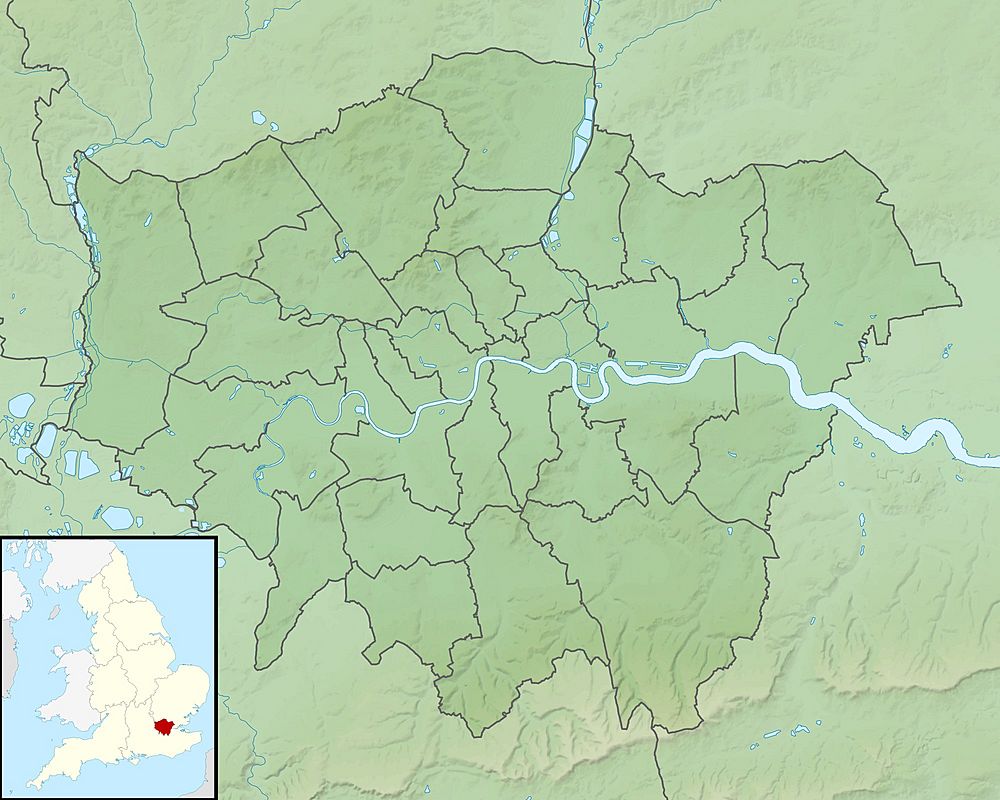Norwood Ridge facts for kids
The Norwood Ridge is a raised area of land in the middle of south London. It's about 10 square miles in size and sits about 5 miles south of London Bridge. This ridge is mostly made of a type of soil called London Clay. On top of the clay, there are natural layers of gravel and sandy soil. This special mix of soil is known as the Claygate Beds in the South Thames area.
Contents
Understanding the Norwood Ridge Area
The Norwood Ridge is shaped like a rectangle and is about 2 miles wide. Its longest part stretches for about 5 miles, starting from central Brockley. Along this length, you'll find three smaller hills, including Rye Hill and Nunhead. The ridge can be seen on maps as three main parts, each with a different height.
The Eastern Ridge: Sydenham Hill Ridge
The highest part is the eastern ridge, also known as the Sydenham Hill Ridge. It runs from One Tree Hill, Honor Oak towards the south-east. This part includes the western areas of Honor Oak and Forest Hill. It also covers Upper Sydenham, the eastern part of Gipsy Hill, and Crystal Palace. Even though the area is often called Crystal Palace now, the road Sydenham Hill still sits on this ridge.
This eastern ridge also includes Upper Norwood, South Norwood Hill, and parts of Thornton Heath and Selhurst, like Grangewood Park. The Crystal Palace transmitting station, which started in 1933, is located here. It's the main television transmitter for the London area. The ridge is generally above 110 meters (360 feet) high. From some spots facing west, you can even see Wimbledon Common, which is a similar height.
The northern parts of the ridge offer narrow views of the tall buildings in Central London. However, the eastern side of the ridge has wide, clear views over Bromley and Addiscombe. You can also see the higher parts of Kent and the North Downs from here.
Many roads lead up to or are part of this ridge. Some of the main ones include:
- Beulah Hill and Upper Beulah Hill
- Spa Hill
- Biggin Hill (not the one further south)
- Norbury Hill
- Convent Hill
- Gibson's Hill
- Grange Hill
- Sylvan Hill and Beaulieu Heights
- Highfield Hill
- Fox Hill
- Westow Hill
- Anerley Hill
- Central Hill
- Salters Hill
- Westwood Hill
- Round Hill
- Derby Hill
- Manor Mount
- Cleve Hill
- Honor Oak Rise
The Central Plateau
The central part of the Norwood Ridge is a bit lower and flatter, like a plateau. From north to south, this area includes East Dulwich, Dulwich, Kingswood Estate with West Dulwich, and West Norwood with Gipsy Hill. Two smaller rises within this central zone are Dawson's Rise and Knight's Hill.
The Western Ridge
The second or western ridge is narrower and slightly lower than the eastern one. It starts broadly in the south around Furzedown and Streatham. Then it runs through central Streatham, Tulse Hill, Herne Hill, and Denmark Hill/Champion Hill. It ends where Dog Kennel Hill, Grove Hill, and Champion Hill meet.
Many roads on this western ridge have "Hill" or "Mount" in their names, such as:
- Bedford Hill
- Mount Ephraim Road and Lane
- Streatham Hill
- Brixton Hill
- Upper Tulse Hill
- Tulse Hill
- Birkbeck Hill
- Herne Hill
- Red Post Hill
- Denmark Hill
- Champion Hill
- Dog Kennel Hill
- Grove Hill
- Bushey Hill
Some of the slopes on the ridge are part of the area where the River Effra used to flow. In the past, many houses and businesses were built along this river. Because of this, the river was turned into underground sewers. These sewers now carry water to the Crossness sewage works and other parts of the tidal Thames. On the eastern side of the ridge, the southern slopes feed into the Pool.
To the south, beneath the ridge, there are layers of London Clay and Palaeocene rock. Between the ridge and the North Downs, you'll find the Graveney stream, which flows into the River Wandle.
The Norwood Ridge and People
Boundaries and Landmarks
The Norwood Ridge and an old oak tree called The Vicars Oak were important for marking the edges of different parishes (local church areas). This is why the Crystal Palace area, in particular, crosses the borders of five London Boroughs: Bromley, Croydon, Lambeth, Southwark, and Lewisham.
The area also falls into three different postcode districts: SE19, SE20, and SE26. The old boundary between the counties of Surrey and Kent also runs through this area. From 1889 to 1965, the Norwood Ridge was on the south-eastern edge of the County of London. Before 1889, it was part of Kent and Surrey. Then, between 1889 and 1965, it included parts of Kent, London, and Surrey.
For many centuries, the area was covered by the Great North Wood. This was a huge natural oak forest that was very close to the growing city of London. People from London loved to visit this forest for fun until the 1800s, when buildings started to be constructed there. Some parts of the area were also home to Gypsies, and you can still find street names and pubs that remember this connection.
Industry and Nature
The clay and brickearth found around the ridge were used for making bricks until the 1900s. Many railway tunnels were also dug through the ridge. Even today, the Norwood Ridge still has many areas of woodland left, showing its natural past.


